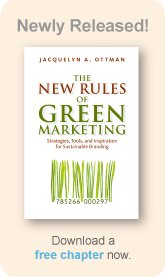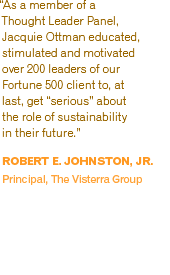What Do We Do Next?
By Jacquelyn A. Ottman
In Business, September 2002
So your company has successfully launched an environmentally preferable product. Perhaps you are offering a more energy efficient washing machine, packaging that has been reduced or eliminated, or you've made a new product from the waste of another. Don't stop now! The real challenge lies ahead: using eco-innovation to reduce environmental impact even more-- and put your company on the cutting edge.
In our consulting practice we invented a toolbox of ideas, strategies, and exercises we call the Getting to Zero(SM) Process for Eco-Innovation. To reach a radical goal of "Zero". Environmental impacts on your business. Ask the following questions to stimulate ideas for short- and long-term action.:
1. How do we teach our consumers to consume and dispose of our products responsibly?
It's all well and good to make your product recyclable, but it will end up in a landfill or a river unless the consumer puts it in the blue bin. And it doesn't matter how energy efficient the air conditioning unit is if the consumer doesn't turn it off when s/he leaves the house. Until you get to "Zero", there will always be some level of responsibility on the part of the consumer to properly consume and dispose of your product. Companies can communicate responsible consumption through labeling, for example, ("Please dispose of this properly") or educational programs. Ask: How can you reward consumers for using your product properly? Do they understand the environmental consequences of improper consumption and disposal? How it will affect their kids?
2. In what ways might we green our company?
Greening corporate culture saves money, reduces turnover, and keeps shareholders happy. Setting internal environmental standards can unleash the creative energy of employees and motivate them to work for a cause they believe in. Ask: Have you conducted an internal environmental audit? Do you have a corporate environmental vision to guide business policy and sustainable innovation? In what ways can you advocate the responsible consumption of office supplies, energy, water, etc., through departmental initiatives? Encouraging these values at the office will surely compel your co-workers to integrate them into their personal and family life as well.
3. Who can work with us?
Constructive partnerships with groups such as consumers, regulators, environmental groups, the media, the scientific community and investors can yield many positive benefits, financial and social. Consider drafting industry-wide environmental standards with competitors. Sharing tangible and knowledge-based resources can be a way to benefit the communities in which you operate and accelerate the progress of your industry. Communicating the benefits of green spreads the word and promotes environmental values among all stakeholders.
4. How might we develop the next evolution of our product?
Eventually, a product's underlying concept becomes the limiting factor to improved environmental performance. In other words, existing products can only be "tweaked" so much before a "leap" to an entirely new or different technology is necessary get closer to "Zero" environmental impact. This is what eco-innovation is all about: addressing your customer's needs in new and exciting ways that promote progressive social values and environmental sustainability. It is, of course, the most challenging˜as well as potentially rewarding˜step a business can take.
For example, products as familiar as a toothbrush and toothpaste may some day be replaced by a biodegradable chewing gum laced with cavity-preventing enzymes. This kind of leap comes from a reevaluated product concept that can inspire groundbreaking cross-sector alliances and totally new marketing campaigns. Ask: what would replace your current product? Hint: it may be a service, rather than a product. Volvo, for one, has moved beyond its combustion engine vehicle business in order to concentrate on sustainable transportation solutions like mass-transit in developing countries and global positioning systems. Another solution is leasing products, as Xerox has explored. Ask: What kinds of creative approach would it take to reduce environmental impact drastically˜radically˜and still meet our consumers' needs?
5. In what ways might we restore the environment?
Most product redesign projects are being conducted with the goal of minimizing environmental impact. But in a world where entire ecosystem like forests and coral reefs are decaying, operating under the current paradigm will only delay the inevitable. Consider developing entirely new products or services that are capable of actually restoring the social, environmental, and economic systems that sustain us. Englehard's Premair ozone catalyst, now standard in Volvos and other makes, actually converts the ozone emissions created by other vehicles into oxygen. Freeplay, makers of a hand-crank radio, supplies their products to developing countries where reliable access to health information is limited. What will you think of next?
*This article was written with the help of Matthew Koltermann.
©Copyright 2002 by J. Ottman Consulting, Inc.



 ShareThis
ShareThis
Jacquelyn Ottman is president of J. Ottman Consulting, Inc., a New York-based marketing consulting firm that specializes in helping businesses derive competitive advantage from eco-innovation and green marketing. She is the author of Green Marketing: Opportunity for Innovation, 2nd edition.
Contact Us to learn more about J. Ottman's green marketing services.
Follow Jacquie on Twitter
Read Jacquie Ottman's Green Marketing Blog
Copyright© 2008 by J. Ottman Consulting, Inc.


